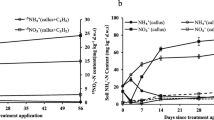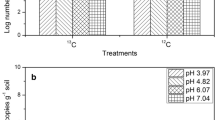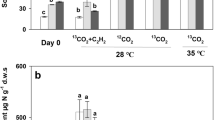Abstract
Background and aims
Global warming is predicted to alter the timing and magnitude of biogeochemical nitrogen cycling in paddy soils. However, little is known about its effect on active nitrifying populations. Here we investigated the responses of nitrification activity and active nitrifiers to elevated temperature in an acidic paddy soil.
Methods
13CO2-DNA-stable isotope probing (SIP), qPCR and high-throughput sequencing were used to determine active nitrifying phylotypes as well as difference in their abundance and community composition incubated at field temperature (15 °C) and elevated temperature (20 °C).
Results
Urea application led to significant production of nitrate and growth of ammonia-oxidizing bacteria (AOB) at both temperatures. Nitrification activity at elevated temperature was 148.3% and 18.5% higher than that of low temperature at day 28 and 56, respectively, accompanied by an increase in the extent of 13C-label incorporation by AOB. 13CO2-based SIP experiment indicated that both AOB and ammonia-oxidizing archaea (AOA) were involved in the nitrification activity and the active ammonia oxidizers changed from AOA to AOB with elevated temperature. Significant variation of AOA communities was observed under different temperatures. Dominant 13C-labeled nitrite-oxidizing bacteria (NOB) shifted from Nitrospira moscoviensis to Nitrospira japonica with higher temperature.
Conclusions
Our findings emphasized that elevated temperature had pronounced effects on autotrophic nitrification which was mediated by altering relative abundance of active AOB and AOA, as well as the community composition of AOA and NOB. AOB were more adaptable than AOA with increasing abundance but no alteration of composition at elevated temperature.





Similar content being viewed by others
Abbreviations
- AOA:
-
Ammonia-oxidizing archaea
- AOB:
-
Ammonia-oxidizing bacteria
- NOB:
-
Nitrite-oxidizing bacteria
- DNA-SIP:
-
DNA-stable isotope probing
References
Alawi M, Off S, Kaya M, Spieck E (2009) Temperature influences the population structure of nitrite-oxidizing bacteria in activated sludge. Environ Microbiol Rep 1:184–190
Allison SM, Prosser JI (1993) Ammonia oxidation at low pH by attached populations of nitrifying bacteria. Soil Biol Biochem 25:935–941
Anderson OE, Boswell FC, Harrison RM (1971) Variations in low temperature adaptability of nitrifiers in acid soils. Soil Sci Soc Amer Proc 35:68–71
Atere CT, Ge TD, Zhu ZK, Liu SL, Huang XZ, Shibsitova O, Guggenberger G, Wu JS (2018) Assimilate allocation by rice and carbon stabilisation in soil: effect of water management and phosphorus fertilization. Plant Soil. https://doi.org/10.1007/s11104-018-03905-x
Avrahami S, Bohannan BJM (2007) Response of Nitrosospira sp. strain AF-like ammonia oxidizers to changes in temperature, soil moisture content, and fertilizer concentration. Appl Environ Microbiol 73:1166–1173
Baer SE, Connelly TL, Sipler RE, Yager PL, Bronk DA (2014) Effect of temperature on rates of ammonium uptake and nitrification in the western coastal Arctic during winter, spring, and summer. Glob Biogeochem Cycles 28:1455–1466
Burton SA, Prosser JI (2001) Autotrophic ammonia oxidation at low pH through urea hydrolysis. Appl Environ Microbiol 67:2952–2957
Cao H, Auguet JC, Gu JD (2013) Global ecological pattern of ammonia-oxidizing archaea. PLoS One 8:e52853
Caporaso JG, Kuczynski J, Stombaugh J, Bittinger K, Bushman FD, Costello EK, Fierer N, Pena AG, Goodrich JK, Gordon JI, Huttley GA, Kelley ST, Knights D, Koenig JE, Ley RE, Lozupone CA, McDonald D, Muegge BD, Pirrung M, Reeder J, Sevinsky JR, Turnbaugh PJ, Walters WA, Widmann J, Yatsunenko T, Zaneveld J, Knight R (2010) QIIME allows analysis of highthroughput community sequencing data. Nat Methods 7:335–336
Daims H, Nielsen JL, Nielsen PH, Schleifer KH, Wagner M (2001) In situ characterization of Nitrospira-like nitrite-oxidizing bacteria active in wastewater treatment plants. Appl Environ Microbiol 71:5273–5284
Di HJ, Cameron KC, Shen JP, Winefield CS, O'Callaghan M, Bowatte S, He JZ (2009) Nitrification driven by bacteria and not archaea in nitrogen-rich grassland soils. Nat Geosci 2:621–624
Di HJ, Cameron KC, Shen JP, Winefield CS, O'Callaghan M, Bowatte S, He JZ (2010) Ammonia-oxidizing bacteria and archaea grow under contrasting soil nitrogen conditions. FEMS Microbiol Ecol 72:386–394
Ehrich S, Behrens D, Lebedeva E, Ludwig W, Bock E (1995) A new obligately chemolithoautotrophic, nitrite-oxidizing bacterium, Nitrospira moscoviensis sp. nov. and its phylogenetic relationship. Arch Microbiol 164:16–23
Fierer N, Carney KM, Horner-Devine MC, Megonigal JP (2009) The biogeography of ammonia-oxidizing bacterial communities in soil. Microb Ecol 58:435–445
Francis CA, Roberts KJ, Beman JM, Santoro AE, Oakley BB (2005) Ubiquity and diversity of ammonia-oxidizing archaea in water columns and sediments of the ocean. Proc Natl Acad Sci U S A 102:14683–14688
Freitag TE, Chang L, Prosser JI (2010) Changes in the community structure and activity of betaproteobacterial ammonia-oxidizing sediment bacteria along a freshwater-marine gradient. Environ Microbiol 8:684–696
Ge TD, Wei XM, Razavi BS, Zhu ZK, Hu YJ, Kuzyakov Y, Jones DL, Wu JS (2017) Stability and dynamics of enzyme activity patterns in the rice rhizosphere: effects of plant growth and temperature. Soil Biol Biochem 113:108–115
Gruber-Dorninger C, Pester M, Kitzinger K, Savio DF, Loy A, Rattei T (2015) Functionally relevant diversity of closely related Nitrospira in activated sludge. ISME J 9:643–655
Grundmann GL, Renault P, Rosso L, Bardin R (1995) Differential effects of soil water content and temperature on nitrification and aeration. Soil Sci Soc Am J 59:1342–1349
He JZ, Shen JP, Zhang LM, Zhu YG, Zheng YM, Xu MG, Di HJ (2007) Quantitative analyses of the abundance and composition of ammonia-oxidizing bacteria and ammonia-oxidizing archaea of a Chinese upland red soil under long-term fertilization practices. Environ Microbiol 9:2364–2374
He JZ, Hu HW, Zhang LM (2012) Current insights into the autotrophic thaumarchaeal ammonia oxidation in acidic soils. Soil Biol Biochem 55:146–154
Höfferle Š, Nicol GW, Pal L, Hacin J, Prosser JI, Mandić-Mulec I (2010) Ammonium supply rate influences archaeal and bacterial ammonia oxidizers in a wetland soil vertical profile. FEMS Microbiol Ecol 74:302–315
Hu HW, He JZ (2017) Comammox-a newly discovered nitrification process in the terrestrial nitrogen cycle. J Soils Sediments 17:2709–2717
Hu BL, Liu S, Shen LD, Zheng P, Xu XY, Lou LP (2012) Effects of different ammonia concentrations on community succession of ammonia-oxidizing microorganisms in a simulated paddy soil column. PLoS One 7:e44122
Hu HW, Zhang LM, Yuan CL, He JZ (2013) Contrasting Euryarchaeota communities between upland and paddy soils exhibited similar pH-impacted biogeographic patterns. Soil Biol Biochem 64:18–27
Hu HW, Zhang LM, Yuan CL, Zheng Y, Wang JT, Chen D, He JZ (2015) The large-scale distribution of ammonia oxidizers in paddy soils is driven by soil pH, geographic distance, and climatic factors. Front Microbiol 6:938
Hu HW, Macdonald CA, Trivedi P, Anderson IC, Zheng Y, Holmes B (2016) Effects of climate warming and elevated CO2 on autotrophic nitrification and nitrifiers in dryland ecosystems. Soil Biol Biochem 92:1–15
IPCC (2013) Climate change 2013: the physical science basis. Contribution of working group I to the fifth assessment reports of the intergovernmental panel on climate change. Cambridge University Press, Cambridge, UK
Jia Z, Conrad R (2009) Bacteria rather than archaea dominate microbial ammonia oxidation in an agricultural soil. Environ Microbiol 11:1658–1671
Jiang XJ, Hou XY, Zhou X, Xin XP, Wright A, Jia ZJ (2015) pH regulates key players of nitrification in paddy soils. Soil Biol Biochem 81:9–16
Karhu K, Auffret MD, Dungait JAJ, Hopkins DW, Prosser JI, Singh BK, Subke JA, Wookey PA, Ågren GI, Sebastià MT, Gouriveau F, Bergkvist G, Meir P, Nottingham AT, Salinas N, Hartley IP (2014) Temperature sensitivity of soil respiration rates enhanced by microbial community response. Nature 513:81–84
Larsen KS, Andresen LC, Beier C, Jonasson S, Albert KR, Ambus PER (2011) Reduced N cycling in response to elevated CO2, warming, and drought in a Danish heathland: synthesizing results of the CLIMAITE project after two years of treatments. Glob Chang Biol 17:1884–1899
Liu H, Ding Y, Zhang Q, Liu X, Xu J, Li Y, Di H (2018) Heterotrophic nitrification and denitrification are the main sources of nitrous oxide in two paddy soils. Plant Soil. https://doi.org/10.1007/s11104-018-3860-x
Long X, Chen C, Xu Z, Oren R, He JZ (2012) Abundance and community structure of ammonia-oxidizing bacteria and archaea in a temperate forest ecosystem under ten-years elevated CO2. Soil Biol Biochem 46:163–171
Luo Y, Yu Z, Zhang K, Xu J, Brookes PC (2016) The properties and functions of biochars in forest ecosystems. J Soils Sediments 16:2005–2020
Luo Y, Zhu Z, Liu S, Peng P, Xu J, Brookes P, Ge T, Wu J (2018) Nitrogen fertilization increases rice rhizodeposition and its stabilization in soil aggregates and the humus fraction. Plant Soil. https://doi.org/10.1007/s11104-018-3833-0
Maixner F, Noguera DR, Anneser B, Stoecker K, Wegl G, Wagner M, Daims H (2006) Nitrite concentration influences the population structure of Nitrospira-like bacteria. Environ Microbiol 8:1487–1495
Malchair S, De Boeck HJ, Lemmens CMHM, Ceulemans R, Merckx R, Nijs I, Carnol M (2010) Diversity-function relationship of ammonia-oxidizing bacteria in soils among functional groups of grassland species under climate warming. Appl Soil Ecol 44:15–23
Malhi SS, McGill WB (1982) Nitrification in three Alberta soils: effect of temperature, moisture and substrate concentration. Soil Biol Biochem 14:393–399
Martens-Habbena W, Berube PM, Urakawa H, José R, Stahl DA (2009) Ammonia oxidation kinetics determine niche separation of nitrifying archaea and Bacteria. Nature 461:976–979
Niboyet A, Le Roux X, Dijkstra P, Hungate BA, Barthes L, Blankinship JC (2011) Testing interactive effects of global environmental changes on soil nitrogen cycling. Ecosphere 2:1–24
Osborne BB, Baron JS, Wallenstein MD (2016) Moisture and temperature controls on nitrification differ among ammonia oxidizer communities from three alpine soil habitats. Front Earth Sci 10:1–12
Pan H, Xie K, Zhang Q, Jia Z, Xu J, Di H, Li Y (2018) Archaea and bacteria respectively dominate nitrification in lightly and heavily grazed soil in a grassland system. Biol Fertil Soils 54:41–54
Rotthauwe JH, Witzel KP, Liesack W (1997) The ammonia monooxygenase structural gene amoA as a functional marker: molecular fine-scale analysis of natural ammonia-oxidizing populations. Appl Environ Microbiol 63:4704–4712
Schimel DS, Braswell BH, Holland EA, McKeown R, Ojima DS, Painter TH (1994) Climatic, edaphic, and biotic controls over storage and turnover of carbon in soils. Glob Biogeochem Cycles 8:279–293
Shaw MR, Harte J (2001) Response of nitrogen cycling to simulated climate change: differential responses along a subalpine ecotone. Glob Chang Biol 7:193–210
Sun R, Guo X, Wang D, Chu H (2015) Effects of long-term application of chemical and organic fertilizers on the abundance of microbial communities involved in the nitrogen cycle. Appl Soil Ecol 95:171–178
Szukics U, Abell GC, Hödl V, Mitter B, Sessitsch A, Hackl E, Zechmeister-Boltenstern S (2010) Nitrifiers and denitrifiers respond rapidly to changed moisture and increasing temperature in a pristine forest soil. FEMS Microbiol Ecol 72:395–406
Tamura K, Dudley J, Nei M, Kumar S (2007) MEGA4: molecular evolutionary genetics analysis (MEGA) software version 4.0. Mol Biol Evol 24:1596–1599
Taylor AE, Giguere AT, Zoebelein CM, Myrold DD, Bottomley PJ (2017) Modeling of soil nitrification responses to temperature reveals thermodynamic differences between ammonia-oxidizing activity of archaea and bacteria. ISME J 11:896–908
Tourna M, Freitag TE, Nicol GW, Prosser JI (2008) Growth, activity and temperature responses of ammonia-oxidizing archaea and bacteria in soil microcosms. Environ Microbiol 7:1985–1995
Ushiki N, Fujitani H, Aoi Y, Tsuneda S (2013) Isolation of Nitrospira belonging to sublineage II from a wastewater treatment plant. Microbes Environ 28:346–353
Ushiki N, Jinno M, Fujitani H, Suenaga T, Terada A, Tsuneda S (2017) Nitrite oxidation kinetics of two Nitrospira strains: the quest for competition and ecological niche differentiation. J Biosci Bioeng 123:581–589
Verhamme DT, Prosser JI, Nicol GW (2011) Ammonia concentration determines differential growth of ammonia-oxidising archaea and bacteria in soil microcosms. ISME J 5:1067–1071
Wang BZ, Zhao J, Guo ZY, Ma J, Xu H, Jia ZJ (2015) Differential contributions of ammonia oxidizers and nitrite oxidizers to nitrification in four paddy soils. ISME J 9:1062–1075
Wang C, Chen Z, Unteregelsbacher S, Lu H, Gschwendtner S, Gasche R (2016) Climate change amplifies gross nitrogen turnover in montane grasslands of Central Europe in both summer and winter seasons. Glob Chang Biol 22:2963–2978
Wei XM, Hu YJ, Peng PQ, Zhu ZK, Atere CT, O'Donnell AG, Wu JS, Ge TD (2017) Effect of P stoichiometry on the abundance of nitrogen-cycle genes in phosphorus-limited paddy soil. Biol Fertil Soils 53:767–776
Xu X, Liu X, Li Y, Ran Y, Liu Y, Zhang Q (2017) High temperatures inhibited the growth of soil bacteria and archaea but not that of fungi and altered nitrous oxide production mechanisms from different nitrogen sources in an acidic soil. Soil Biol Biochem 107:168–179
Yu MJ, Yu L, Su W, Afzal M, Li Y, Brookes PC, Redmile-Gordon M, Luo Y, Xu J (2018) Changes in nitrogen related functional genes along soil pH, C and nutrient gradients in the charosphere. Sci Total Environ 650:626–632
Zhang JJ, Li YF, Chang SX, Qin H, Fu SL, Jiang PK (2015) Understory management and fertilization affected soil greenhouse gas emissions and labile organic carbon pools in a Chinese chestnut plantation. For Ecol Manag 337:126–134
Zhang Q, Li Y, He Y, Liu H, Dumont MG, Brookes PC, Xu J (2019) Nitrosospira cluster 3-like bacterial ammonia oxidizers and Nitrospira-like nitrite oxidizers dominate nitrification activity in acidic terrace paddy soils. Soil Biol Biochem 131:229–237. https://doi.org/10.1016/j.soilbio.2019.01.006
Zhu G, Wang S, Wang Y, Wang C, Risgaard-Petersen N, Jetten MS, Yin C (2011) Anaerobic ammonia oxidation in a fertilized paddy soil. ISME J 5:1905–1912
Zhu ZK, Ge TD, Liu SL, Hu YJ, Ye RZ, Xiao ML, Tong CL, Kuzyakov Y, Wu JS (2018) Rice rhizodeposits affect organic matter priming in paddy soil: the role of N fertilization and plant growth for enzyme activities, CO2 and CH4 emissions. Soil Biol Biochem 116:369–377
Acknowledgements
This research was financially supported by the National Natural Science Foundation of China (41721001 and 41671249).
Author information
Authors and Affiliations
Corresponding author
Additional information
Responsible Editor: Zucong Cai.
Publisher’s note
Springer Nature remains neutral with regard to jurisdictional claims in published maps and institutional affiliations.
Electronic supplementary material
ESM 1
(DOCX 1523 kb)
Rights and permissions
About this article
Cite this article
Zhang, Q., Li, Y., He, Y. et al. Elevated temperature increased nitrification activity by stimulating AOB growth and activity in an acidic paddy soil. Plant Soil 445, 71–83 (2019). https://doi.org/10.1007/s11104-019-04052-7
Received:
Accepted:
Published:
Issue Date:
DOI: https://doi.org/10.1007/s11104-019-04052-7




